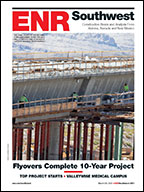As engineering and construction industry officials look at federal government developments in 2015, the highlights came at the end of the year.
The top congressional action, by far, was the long-desired enactment, on Dec. 4, of a multi-year surface transportation bill. The legislation, the Fixing America’s Surface Transportation Act (FAST), authorizes $305 billion for highway, transit and Amtrak programs over five years. It is the first transportation bill of that length to go on the books since 2005.
Besides providing certainty for state and local transportation agencies—and engineering and construction firms that rely on their contracts—the FAST Act provides strong increases for fiscal 2016, the measure’s first year. ENR calculates that the highway obligation limit will rise 5% this fiscal year. The American Road & Transportation Builders Association estimates that 2016 transit funding will climb 10%.
But in the legislation’s last four years, the highway ceiling’s annual boosts will be modest, averaging only about 2.3%, according to ENR. Transit’s increases over that period will average just 1.7%, according to ARTBA.
Another piece of welcome year-end news came on Dec. 18, when President Obama signed a tax-cut and omnibus spending package that will provide substantial fiscal 2016 hikes for some major construction programs.
Compared with the past three years’ spending levels, “This is a very good year for construction,” says Jimmy Christianson, director of government affairs for the Associated General Contractors of America’s federal and heavy construction division.
Christianson adds, “We’re happy about the omnibus. We wish it would have come three months ago so that the agencies can plan.”
General Services Administration and Dept. of Veterans Affairs programs won strikingly large boosts in the $1.1-trillion government-wide appropriations measure, with GSA’s construction and acquisition account more than tripling, to $1.6 billion, and VA’s major projects budget more than doubling, to $1.2 billion.
The omnibus appropriations measure also locked in the FAST Act’s positive 2016 numbers for federal highway and transit programs and hiked Dept. of Defense construction by 16%.
Not all construction accounts fared that well. For example, State Dept. spending on embassy security upgrades and construction and upgrades was cut 16%, and the Environmental Protection Agency’s water infrastructure program was trimmed, but only by a slight 0.8%.
The $622-billion tax portion of the legislation will extend a long list of expired credits and other incentives. Construction-industry officials were pleased to see the legislation’s permanent extension of the tax code’s Section 179 provision allowing small companies to expense the costs of heavy equipment and other capital purchases.
The American Institute of Architects praised a provision extending through 2016 a deduction for energy-efficient commercial buildings. Credits for renewable energy projects also were extended.
House Speaker John Boehner rocked his GOP caucus with his Sept. 25 announcement that he would resign as speaker and resign his Ohio House seat on Oct. 30. Ways and Means Committee Chairman Paul Ryan (Wis.) was elected as Boehner’s successor.
But before Boehner stepped down, he helped lay the groundwork for the December omnibus spending package. He was credited with playing a key role in striking a deal with key Democrats and the White House on overall discretionary spending levels for 2016 and 2017.
That two-year budget pact, enacted on Nov. 2, postponed mandatory “sequestration” spending cuts and added additional defense and non-defense spending. The budget measure also raises the U.S. debt ceiling through March 15, 2016.
Surety industry officials hailed provisions in the 2016 DOD authorization bill, signed into law on Nov. 25, that would put more restrictions on the use of individual surety bonds.
One major disappointment to the construction community was the administration’s decision to reject Calgary-based TransCanada’s application to build additional sections of the Keystone XL pipeline from the Tar Sands region in Alberta to Hardisty, Neb. Though not unexpected, the decision was a blow to labor unions and other proponents who said that the project would create thousands of jobs. Some construction groups noted that crude oil from the Tar sands will continue to move through the U.S., but rather than through a pipeline, it will more likely be transported via riskier rail and trucks. Still, environmental groups cheered the decision, noting that crude from the Tar Sands region burns dirtier and would contribute to climate change.






Post a comment to this article
Report Abusive Comment